
A leptocephalus is the flat and transparent larva of the eel, marine eels, and other members of the superorder Elopomorpha. This is one of the most diverse groups of teleosts, containing 801 species in 4 orders, 24 families, and 156 genera. This group is thought to have arisen in the Cretaceous period over 140 million years ago.
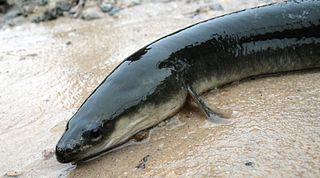
The American eel is a facultative catadromous fish found on the eastern coast of North America. Freshwater eels are fish belonging to the elopomorph superorder, a group of phylogenetically ancient teleosts. The American eel has a slender, supple, snake-like body that is covered with a mucus layer, which makes the eel appear to be naked and slimy despite the presence of minute scales. A long dorsal fin runs from the middle of the back and is continuous with a similar ventral fin. Pelvic fins are absent, and relatively small pectoral fins can be found near the midline, followed by the head and gill covers. Variations exist in coloration, from olive green, brown shading to greenish-yellow and light gray or white on the belly. Eels from clear water are often lighter than those from dark, tannic acid streams.

Mycteroperca bonaci, the black grouper, black rockfish or marbled rockfish, is a species of marine ray-finned fish, a grouper from the subfamily Epinephelinae which is part of the family Serranidae, which also includes the anthias and sea basses. Other fish are sometimes called the black grouper including the similar gag grouper, the misty grouper, and the warsaw grouper. This species is found in the western Atlantic Ocean from the northeastern United States to Brazil.
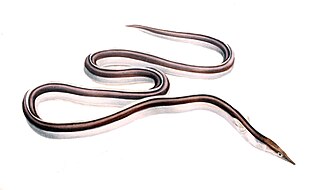
The serpent eel or sand snake-eel is an eel found in the eastern Atlantic Ocean, western Mediterranean Sea, western Indian Ocean, western Pacific Ocean and the north-east and west coast of North Island in New Zealand. It is an elongated, slender fish with a length of up to 250 centimetres. It spends the day with its body immersed in the sediment, emerging into the open water at night.

The dwarf catshark is a catshark, belonging to the family Scyliorhinidae. It is found off the coast of southern Florida, the Bahamas, and Cuba and is also known as the whitespotted catshark and Cuban catshark.

The West African catshark is a catshark of the family Scyliorhinidae. It is found in the eastern Atlantic between latitudes 20° N and 17° S, at depths between 45 and 500 m. It can grow up to a length of 80 centimetres (31 in). At one time, the West African catshark was considered to be a subspecies of the nursehound, Scyliorhinus stellaris, but is now considered to be a separate species. The reproduction of this catshark is oviparous.

The giant mottled eel, also known as the marbled eel, is a species of tropical anguillid eel that is found in the Indo-Pacific and adjacent freshwater habitats.
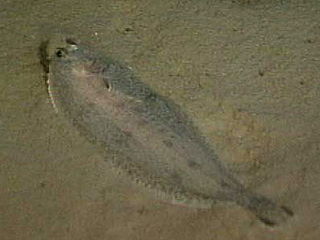
The witch, known in English by a variety of other common names including the witch flounder, pole flounder, craig fluke, Torbay sole, and grey sole, is a species of flatfish from the family Pleuronectidae. It occurs on both sides of the North Atlantic Ocean on muddy sea beds in quite deep water. In northern Europe it has some importance in fisheries as a food fish.

The European conger is a species of conger of the family Congridae. It is the heaviest eel in the world and native to the northeast Atlantic, including the Mediterranean Sea.

Chromis chromis, the damselfish or Mediterranean chromis, is a small species of ray-finned fish of the family Pomacentridae from the Eastern Atlantic and Mediterranean.

Eels are ray-finned fish belonging to the order Anguilliformes, which consists of eight suborders, 20 families, 164 genera, and about 1000 species. Eels undergo considerable development from the early larval stage to the eventual adult stage and are usually predators.
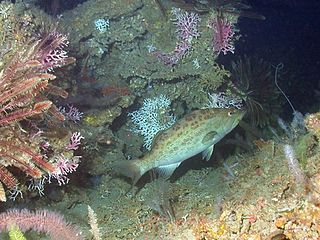
The scamp grouper, also known as scamp, is a species of marine ray-finned fish, a grouper from the subfamily Epinephelinae which is part of the family Serranidae, which also includes the anthias and sea basses. It is found in the western Atlantic Ocean.

Menticirrhus saxatilis, the northern kingfish or northern kingcroaker, is a species of marine fish in the family Sciaenidae. It lives in the shallow coastal waters of the western Atlantic Ocean and Gulf of Mexico.
The yellowmouth grouper, also known as the crossband rockfish, grey mannock, hamlet, harlequin rockfish, princess rockfish, rockfish, salmon grouper, salmon rock fish or scamp, is a species of marine ray-finned fish, a grouper from the subfamily Epinephelinae which is part of the family Serranidae, which also includes the anthias and sea basses. It is found in the Caribbean and in the tropical waters of the Atlantic Ocean. It is also found in pockets in Brazil. It is a fairly large fish and it gets its name from the yellow around its mouth.

The blackfin snapper, also known as the blackspot snapper, blackfin red snapper, gun-mouth backfin, gun-mouth snapper, redfish and wrenchman is a species of marine ray-finned fish, a snapper belonging to the family Lutjanidae. It is native to the western Atlantic Ocean. It is a commercially important species, though it has been reported to carry the ciguatera toxin.

Dysommina rugosa is an eel in the family Synaphobranchidae. It was described by Isaac Ginsburg in 1951. It is a marine, deep water-dwelling eel which is known from the western Atlantic and eastern central Pacific Ocean. It dwells at a depth range of 260–775 metres, and is found off the continental slope. Males can reach a maximum total length of 37 centimetres.

The Gulf butterfish is a fish species of the family Stromateidae found in the Gulf of Mexico and off the coast of the Eastern United States.
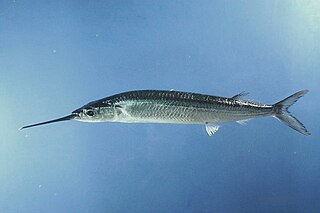
Hyporhamphus unifasciatus, the common halfbeak or the Atlantic silverstripe halfbeak, is a bony fish in the family Hemiramphidae. It is found in the subtropical western Atlantic Ocean and the Gulf of Mexico. It is a common fish and not used for food to any great extent, and the International Union for Conservation of Nature has listed its conservation status as being of "least concern".

Hyporthodus mystacinus, the misty grouper, black grouper, convict grouper, eightbar grouper or moustache grouper, is a species of marine ray-finned fish, a grouper from the subfamily Epinephelinae which is part of the family Serranidae, which also includes the anthias and sea basses. It is primarily found in the Caribbean and the Gulf of Mexico with populations present around the Galapagos Islands and Central American coastlines.
The Pacific bearded brotula also known as the pink bearded cusk-eel or the red bearded cusk-eel is a species of cusk eel found in the Pacific Ocean. It is described as being reddish-brown with dark fins.



















